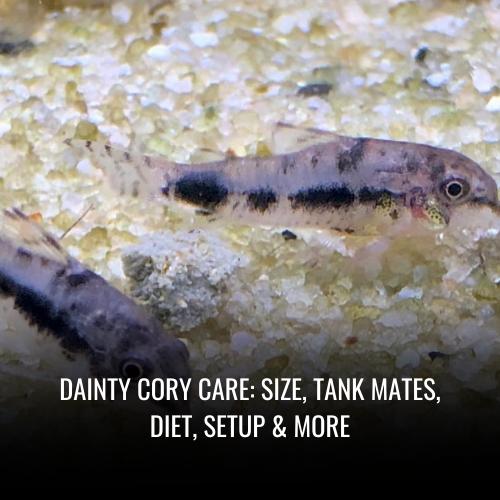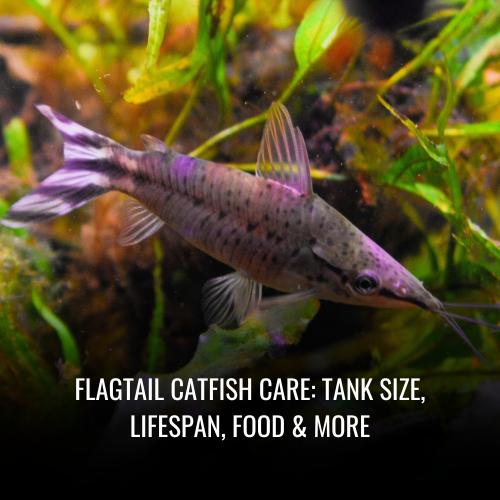Shark Catfish, also known as Pangasius hypophthalmus or the Iridescent Shark, is a striking freshwater fish species popular among aquarium enthusiasts and in commercial fish farming. These active fish can grow up to a formidable size, making them suited for large gallon tanks. Below is a quick-reference table containing essential information about Shark Catfish:
| Scientific name: | Pangasius hypophthalmus |
|---|---|
| Common names: | Sutchi Catfish, Iridescent Shark |
| Family: | Pangasiidae |
| Usual Size: | Up to 1.5 meters in length |
| pH Range: | 6.5 – 7.5 |
| dGH: | 5-15 |
| Temperature: | 22-26°C (72-79°F) |
| Reproduction: | Egg layer |
| Origin: | Mekong basin & Chao Phraya River |
| Temperament: | Peaceful |
| Tank Position: | Middle dwelling |
| Lifespan: | 10-15 years |
| Tank Size: | Minimum 300 gallons |
| Filtration: | Strong, capable of handling high bioload |
With its long, slender body and iridescent skin, the Shark Catfish is a visually appealing addition to freshwater tanks. They require a varied diet of meaty and frozen foods like bloodworms and thrive in schools, suited to brackish waters as they mature. Given their size and specific water parameters, they are considered an option for intermediate fish keepers.
Scientific Name
The Shark Catfish, scientifically recognized as Pangasius hypophthalmus, is a fascinating freshwater fish species from the Pangasiidae family. This migratory species has adapted to the dynamic environments of Southeast Asia’s vast river systems, notably the Mekong and Chao Phraya basins. With its notable ability to traverse long distances across these freshwater habitats, the Shark Catfish exhibits a remarkable life cycle synonymous with adventure and adaptability.
Below is a glance at the key scientific categorization of the Shark Catfish:
| Taxonomic Category | Information |
|---|---|
| Kingdom | Animalia |
| Phylum | Chordata |
| Class | Actinopterygii |
| Order | Siluriformes |
| Family | Pangasiidae |
| Genus | Pangasius |
| Species | Pangasius hypophthalmus |
Often referred to by its various common names such as the Iridescent Shark, Sutchi Catfish, and Chao Phraya, Pangasius hypophthalmus captivates aquatic enthusiasts with its elegant appearance and resilience. Whether identified through scientific nomenclature or its colloquial monikers, the Shark Catfish remains an intriguing subject for those interested in the diversity of freshwater fish species.
Average Size
The Shark Catfish is a true giant among freshwater fish species, with an average adult size that can reach an imposing length of nearly 9 feet. This immense size establishes it as one of the most sizable freshwater fish in the world, commanding attention and awe within aquatic communities.
Average Size of Shark Catfish
| Measurement | Description |
|---|---|
| Length | Up to 9 feet |
| Global Ranking | Among largest freshwater fish |
While their grandeur is indisputable, the populations of these majestic fish are in a critical state due to overfishing. It has become increasingly rare to witness these colossal creatures due to their classification as critically endangered in natural settings. Human activities, such as dam construction and habitat destruction, have dramatically altered their habitat. Changes to the environment impede traditional migratory patterns, with the Upper Mekong Navigation Improvement Project particularly affecting the Shark Catfish by disrupting the natural cycles of floods and droughts essential for their survival.
This combination of overfishing and habitat disruption makes the future uncertain for these impressive fish, shining a light on the need for conservation efforts to protect such extraordinary members of the freshwater community.
Lifespan
The Shark Catfish, a captivating member of the freshwater fish community, can enjoy a significant lifespan when maintained under ideal conditions. In captivity, these peaceful fish have an average life expectancy of about 10 years. However, with meticulous care, some Shark Catfish may surpass this average, living for several additional years in a well-managed freshwater tank.
A varied diet is essential for their well-being, incorporating high-quality, meaty foods like blood worms and other frozen foods suitable for carnivorous freshwater species. In contrast, subpar living conditions and nutritional deficiencies can drastically shorten their lifespan.
Proactive care, including vigilance for any symptoms of distress or disease, is imperative. Prompt responses to health issues are key to maximizing the longevity of these Shark Catfish, making them a rewarding choice for dedicated aquarists.
| Key Factors Affecting Lifespan | Importance |
|---|---|
| Tank Size | Provides room for growth and exercise |
| Water Quality | Prevents disease and stress |
| Balanced Diet | Supplies necessary nutrients |
| Disease Management | Ensures timely treatment |
Natural Habitat
The ethereal Iridescent Shark Catfish, or scientific name Pangasius hypophthalmus, holds its origins in the majestic river systems of Southeast Asia. Specifically, it hails from the murky, flowing expanses of the Chao Phraya and Mekong rivers. In these warm, tropical freshwater settings, the Iridescent Shark thrives best, showing a preference for the substantial channels and tributaries within these rivers.
These sharks are accustomed to a natural environment that boasts a pH range of 6.5 to 7.5, a water hardness of 2.0 to 29 dGH, and a cozy temperature bracket of 22 to 26°C (72 to 79°F). Remarkably, Iridescent Sharks exhibit characteristics of a migratory species, engaging in upstream spawning expeditions during the flood season. This seasonal journey reflects the river’s fluctuating rhythms, with the species moving downstream when waters recede.
| Water Condition | Suitable Range |
|---|---|
| pH | 6.5 – 7.5 |
| Hardness (dGH) | 2.0 – 29 |
| Temperature | 22 – 26 °C (72 – 79 °F) |
Adept at navigating their fluid world, these catfish even dwell in brackish waters and adapt to various river habitats. Such adaptability has led to their introduction into different rivers and aquaculture environments beyond their native range, where they continue to flourish.
Appearance
The Iridescent Shark Catfish is an aquatic marvel, endowed with a sleek and lustrous silver body that elegantly tapers into a deeply forked tail. Its adipose fin stands out prominently, contributing to the fish’s classic shark-like silhouette. In the wild, this species can achieve a considerable size, growing to a formidable length of up to three feet, securing its spot among the largest species to grace freshwater home aquariums.
| Key Feature | Description |
|---|---|
| Body Color | Metallic Silver |
| Fins | Deeply Forked Tail; Notable Adipose Fin |
| Adult Size | Up to Three Feet in Length |
As light dances across the water, the Iridescent Shark’s metallic sheen is set aglow, displaying captivating hues of blue and silver that gleam off its streamlined body. The fish is further adorned with barbels, resembling elongated wisps, which serve as sensory tools to navigate the shadowy riverbeds of its natural habitat.
Occasionally, one may observe scattered black spots or markings embellishing its body, which set against the fish’s shimmering silver backdrop, create a visually appealing contrast. The interplay of color and form makes the Iridescent Shark Catfish a stunning centerpiece in any freshwater aquarium.
Behavior & Temperament
Shark catfish, encompassing species such as the Iridescent Shark (Pangasius hypophthalmus), the Tete Sea Catfish (Ariopsis seemanni), and the Sutchi Catfish, present a unique blend of serene grace and mystique within the confines of a freshwater tank. As nocturnal creatures, their activity crescendos under the moon’s watchful eye, painting the darkened aquarium with their elegant, meandering motions.
Known for their calm demeanor, these fish are tantamount to underwater ambassadors of peace, navigating the watery depths with an absence of hostility. This pacific nature underpins their eligibility as ideal candidates for community aquariums, harmonizing effortlessly with a variety of other freshwater fish species.
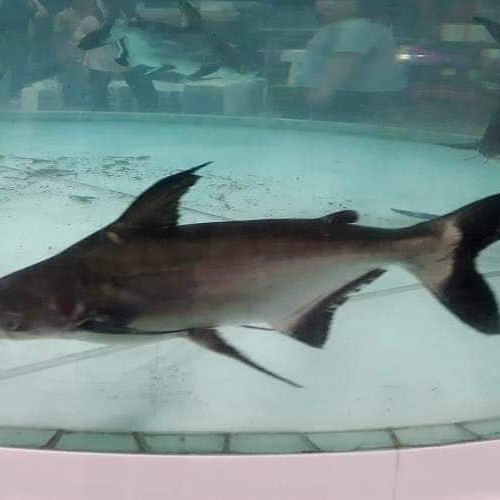
Are Shark Catfish Fin Nippers?
Shark catfish are typically not fin nippers. Their disposition is peaceful, making them unlikely to engage in aggressive interactions with their tank mates. Their anatomy, with a flattened head and sweeping barbels, is designed for foraging along the substrate rather than chasing and nipping fins. Tank owners can prioritize finding compatible companions for their shark catfish without the worry of fostering fin-nipping behaviors.
Are Shark Catfish Aggressive To Each Other & Other Fish?
Amidst the tranquility of a well-established freshwater tank, shark catfish demonstrate that aggression is not their modus operandi. Aggression is rarely seen, even amongst conspecifics, provided there is ample space and resources. Instead, they channel their energy into peaceful coexistence, proving to be non-threatening neighbors for other community fish. When selecting tank mates, aiming for those of a similar peaceful nature and ample size is prudent, ensuring that all residents feel secure without the fear of predation.
Are Shark Catfish Friendly To Each Other & Other Fish?
The social fabric woven by shark catfish is one of camaraderie and collegiality. They exude friendliness toward each other, often forming shoals that provide a reassuring presence. This sociability extends to their interactions with other fish, where they showcase a peaceful temperament—a quality that renders them excellent community members. Nevertheless, compatibility should be assessed on a case-by-case basis, taking into consideration the individual species’ requirements and demeanor.
Are Shark Catfish Schooling Fish?
Schooling is an innate behavior for shark catfish, a testament to their migratory routes in the wild. These fish thrive in a group dynamic, showcasing synchronized swimming that is not only a visual delight but also a reflection of their natural inclinations. In the aquarium, maintaining a shoal of at least three shark catfish can be vital for their well-being, enabling them to express their gregarious nature and reinforcing their sense of security.
Can You Have Just One Shark Catfish In The Tank?
While a solitary shark catfish can technically survive in an aquarium, it is a scenario far from ideal. The absence of conspecific companions can lead to heightened stress and resulting health complications. An individual may become reclusive and exhibit shyness, which is in stark contrast to their authentic vivacious spirit. To avoid such circumstances, it is advised to honor their preference for company and opt for a sociable setup for these majestic fish.
Do Shark Catfish Need To Be In Groups?
The social fabric of the shark catfish does indeed necessitate a group setting. Solitude is an unwelcome state for these community-oriented swimmers, where lack of companionship can incite a decline in behavioral and physiological health. They exhibit a robust sense of unity when in groups, often partaking in a mesmerizing aquatic ballet that reflects their natural demeanor. As such, aquarium enthusiasts are encouraged to foster this social structure and maintain a minimum group size that allows for adequate interaction and comfort.
In managing water parameters for these active fish, be it a Sutchi catfish or an Iridescent Shark, aquarists must engineer an environment that mimics their natural habitat. From maintaining optimal water parameters—neutral pH, moderate hardness—accommodating their potential adult size to ensuring a varied diet, the aim should be to replicate the conditions of the rivers they originate from, be it the Chao Phraya or brackish waters of other regions. Offering a balanced menu—from blood worms to meaty, frozen foods—facilitates their growth and coloration, ensuring they remain energized and healthy within their freshwater or brackish domain.
Food & Diet
Shark catfish, known for their opportunistic feeding habits, are omnivores with a strong preference for protein-rich foods. In their juvenile stage, they particularly require substantial protein intake to ensure proper growth and development. In the wild, their diet is eclectic, including small fish, insects, crustaceans, and carrion. For those raising shark catfish in a captive environment, it becomes essential to offer a balanced diet that incorporates both animal and plant matter to satisfy their nutritional needs.
Given their carnivorous leaning, it’s important to include foods such as live shrimp, earthworms, mussels, and prawns, which these fish seek using their sensitive barbels and electroreception—similar to true sharks. As they mature, their diet should evolve to include a higher proportion of vegetables like spinach leaves, frozen peas, and offerings containing Spirulina, though they will continue to enjoy meaty fares like fish strips, octopus, and sinking tablets.
It’s important to note that feeding frequency plays a crucial role, especially during their rapid growth phase, necessitating multiple feedings a day. A diet that alternates between high-quality flake or pellet food, live foods, and frozen varieties ensures they receive all the necessary nutrients for a healthy life in captivity.
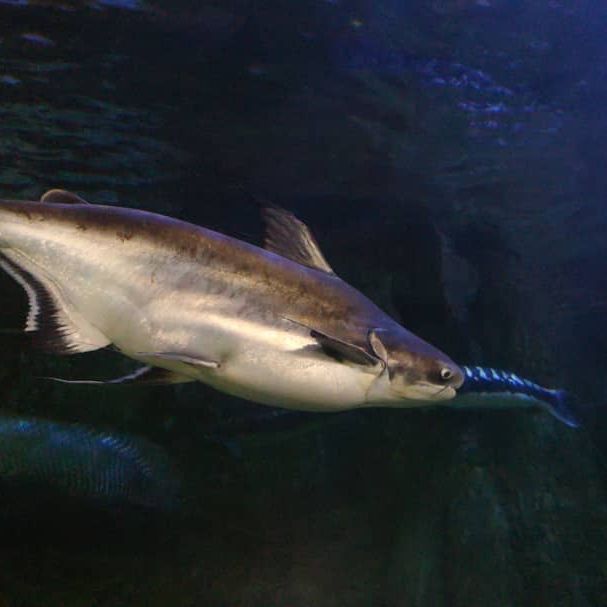
Do Shark Catfish Eat Algae?
Contrary to some freshwater species, shark catfish do not primarily consume algae. Their natural diet consists mainly of living prey such as smaller fish, crustaceans, and insects. While they might incidentally nibble on algae present in their habitat, it does not constitute a major part of their nutrition.
In captivity, ensuring a varied diet rich in commercial pellets and meaty foods, with occasional vegetable supplements, supports the growth and health of shark catfish, effectively reducing any inclination to graze on algae in the tank.
Do Shark Catfish Eat Shrimp?
Shrimp form an appetizing part of the shark catfish’s diet, both in the wild and within the aquarium. They are well-suited to be included in the feeding regimen of these fish, offering a hearty supply of protein and closely resembling their natural food sources.
Shrimp, whether live or included in high-quality processed foods, serve as nourishing meals that encourage the catfish’s predatory instinct and contribute to their overall well-being.
Do Shark Catfish Eat Bloodworms?
Bloodworms are a tantalizing choice for shark catfish and are readily accepted as part of their captive diet. Offering high protein content, bloodworms—whether live or frozen—serve as a nutritious staple that aids in maintaining the vitality and health of these fish.
Feeding bloodworms align with their natural feeding behavior and supports a diverse and well-rounded dietary plan, vital for any thriving aquarium inhabitant.
Do Shark Catfish Eat Mosquito Larvae?
Shark catfish readily feed on mosquito larvae in their environment, constituting a naturally occurring and protein-packed food source. Feeding mosquito larvae to shark catfish in an aquarium is a great way to recreate their typical predatory patterns and supply a nutritious supplement that supports their overall health. It also provides behavioral enrichment, keeping the catfish engaged and satisfied in their man-made habitats.
Do Shark Catfish Eat Planaria?
While not a primary dietary item, shark catfish will consume planaria when encountered. These small flatworms, often found in freshwater settings, provide an additional nourishment source assisting in diversifying the catfish’s intake. Using their sensitive barbels, shark catfish can detect and ingest these invertebrates, thereby helping to maintain the ecological balance within the tank ecosystem.
Do Shark Catfish Eat Plants?
Typically, shark catfish’s carnivorous nature means that plants do not make up a significant part of their diet. However, in some cases, these fish may nip at tender plants in the aquarium, particularly if their dietary needs are not being met with protein-rich foods.
To keep your shark catfish from turning to plants for sustenance, ensure they are fed a varied and well-balanced diet. Providing an array of hiding spots and including plant-based foods as a minor component of their diet can prevent the consumption of ornamental aquarium plants.
Sexing: Male vs Female
Understanding the gender of juvenile shark catfish can be perplexing, as there are no notable physical differences to identify males from females. It’s only upon maturity that these fish reveal sexual dimorphism. Adult female shark catfish are distinguished by their fuller figures, in contrast to the slender contour of the males. A visual cue to discern a mature female is the presence of lighter finnage, which sets them apart from the darker fins of the males.
As the shark catfish reach adulthood, usually around 8 inches in length, the differences become increasingly evident. Observing the broader, more rounded body shape is key in identifying females. These contrasts in appearance are essential indicators for those keen on sexing shark catfish in their freshwater tanks.
| Gender | Body Thickness | Fin Color |
|---|---|---|
| Female | Thicker, Robust | Lighter |
| Male | Slender | Darker |
Shark catfish Tank Mates
When integrating shark catfish into a community fish tank, the selection of tank mates is crucial for maintaining harmony. Suitable companions for these tranquil freshwater fish include other peaceful and larger species. Tetras, rasboras, loaches, and non-aggressive cichlids make excellent comrades due to their peaceful nature and the ability to coexist with the shark catfish’s size and energy.
However, aquarists should refrain from adding smaller fish that shark catfish may mistakenly target as food. The ample adult size and vivaciousness of shark catfish necessitate a generous aquarium space to accommodate their swimming needs and active fish behaviors.
Exhibit caution when choosing tank mates; aggressive or territorial marine fish may intimidate shark catfish, leading to unnecessary stress. Coexisting with other bottom dwellers is possible, provided the tank offers abundant space and nooks for refuge, curbing territorial clashes.
Here’s a simple tabulation on potential tank mates for Shark Catfish:
| Compatible Species | Reasons for Compatibility |
|---|---|
| Tetras | Peaceful, large enough to not be prey |
| Rasboras | Peaceful, can match activity levels |
| Loaches | Peaceful bottom dwellers with similar size |
| Peaceful Cichlids | Larger and non-aggressive |
| Incompatible Species | Reasons for Incompatibility |
| Small Fish | Risk of being eaten |
| Aggressive Fish | Can bully or stress shark catfish |
Aquarium Setup
Creating the right home for Shark Catfish involves carefully planning your aquarium setup to cater to their specific needs. These active and sizable freshwater fish demand substantial space, proper water conditions, and specific equipment to keep them healthy and thriving. The setup must replicate their natural riverine habitat as much as possible, which includes ample swimming space, consistent water parameters, efficient filtration, and appropriate lighting.
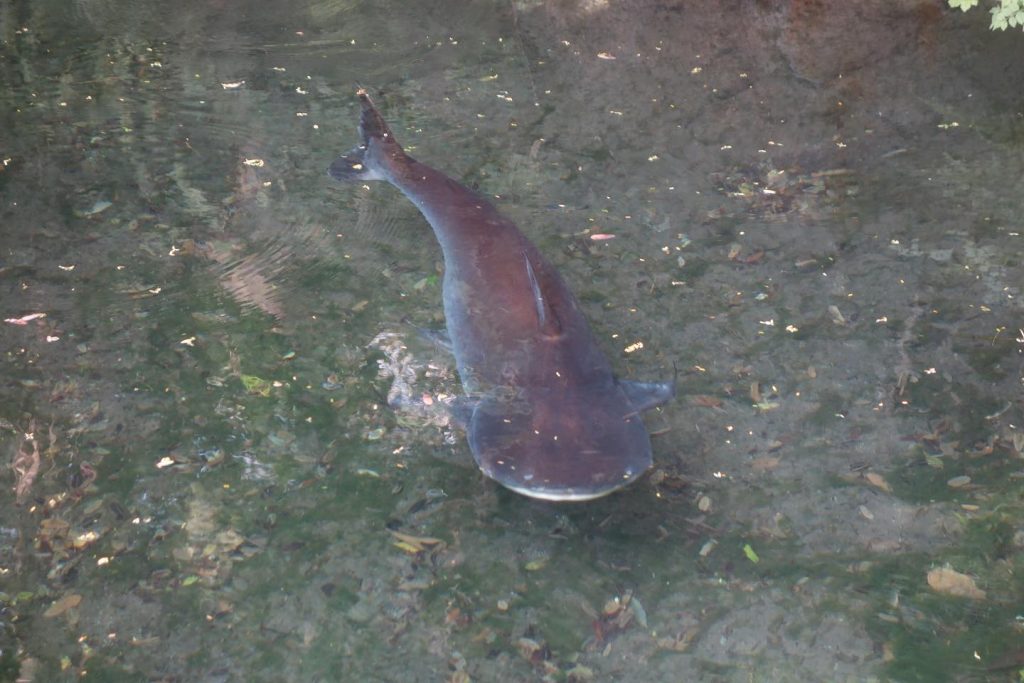
Ideal Tank Size
The tank size for Shark Catfish, whether it’s the Silver-tipped Sharks or the broader category of species, is critical for their well-being. For Silver-tipped Sharks, a single fish requires a minimum of 75 gallons, but if you plan on keeping a group, start with at least 100 gallons. With Shark Catfish being especially active swimmers, they thrive in very large tanks.
It’s recommended to provide a tank that is at least 15 feet in length, 6 feet in width, and 6 feet in depth, totaling an approximate volume of 14,580 liters. Smaller tanks for juveniles are only a temporary solution, as they will need relocation to larger aquariums as they grow to avoid stress and injury from cramped conditions.
Ideal Water Parameters
Shark Catfish are adaptable and can tolerate a range of water parameters, which is reflective of their tendency to inhabit waters that undergo frequent changes in the wild. The water temperature should be kept between 72 to 79°F (22 to 26°C), and the pH level maintained within 6.5 to 7.5.
While young fish can be kept in freshwater, adults may require a slightly brackish environment. The specific gravity should not fall below 1.002 sg, and for adult Shark Catfish, a higher specific gravity of around 1.010 is preferred. Regular water changes and monitoring are essential to keep these parameters stable.
Filtration
Owing to their significant waste production, Shark Catfish demand a robust filtration system. A combination of a canister filter and a sump system is often recommended to manage the biological load efficiently. To eliminate solid waste, a high-quality mechanical foam filter is essential.
Additionally, incorporating a powerful water pump ensures proper circulation, keeping the tank water clean and well-oxygenated, which is vital for the health of Shark Catfish. Routine maintenance of the filtration system, including cleaning and replacing filter media, is a must to prevent the accumulation of detritus and maintain superior water quality.
Lighting
The lighting in an aquarium for Shark Catfish should be catered to the needs of both the fish and any live plants included in the setup. Options include energy-efficient LEDs, fluorescents, and compact fluorescents (CFLs), all of which can be used according to personal preference and requirement. Lighting should ideally be soft to simulate the subdued lighting of their natural habitat, which can be achieved with dimmable lights or by providing shaded areas with decorations.
Lighting should be regulated to mimic natural cycles, with the aid of a timer to maintain a consistent day and night rhythm, encouraging a healthy lifestyle for the Shark Catfish and any live plants within the tank. Regular monitoring is necessary to ensure that light levels are appropriate and to prevent the growth of algae, which can occur with excessive lighting.
Common Possible Diseases & Prevention
Shark Catfish, including species like the Black Shark Catfish, are susceptible to health issues stemming from poor water conditions. To ensure their well-being:
Prevention Practices:
- Maintain water quality: Perform regular water changes, keeping nitrate levels below 20 ppm to protect barbels and overall health.
- Diversify diet: Offer a varied diet to bolster their immune system. Include staples like meaty and frozen foods alongside special treats such as blood worms.
- Gentle medication: Being scaleless, Shark Catfish are sensitive to certain treatments. Use mild medications like Pimafix or Melafix, and halve doses of Malachite green or Formalin for safety.
- Quarantine additions: New fish or tank decor should be quarantined and thoroughly cleaned to avoid introducing diseases.
By enforcing these preventative measures, you can reduce the chance of diseases like bacterial and fungal infections or parasitic issues such as Ich. Strict adherence to these guidelines promotes a healthy, disease-free environment for your Shark Catfish.
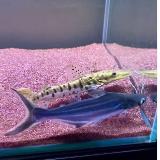
Breeding Shark catfish In Aquarium
Breeding the elusive Black Shark Catfish in home aquariums presents a distinct set of challenges. An expansive tank with strong water circulation mimics their natural riverine habitats, providing the ideal breeding ground. Water quality is paramount—nitrates should be minimal, pH levels stable, and the temperature consistent.
Key Breeding Conditions:
- Large Tank: Mimic their natural environment with ample space and water flow.
- Varied Diet: Ensure the parents and fry have access to a nutritious diet.
When conditions align, a female can lay a staggering number of up to 10,000 eggs. These eggs hatch within a 24 to 36-hour window, revealing the free-swimming fry. At this critical stage, feeding becomes a central concern.
Optimal Fry Nutrition:
- Infusoria: Tiny organisms perfect for initial fry meals.
- Brine Shrimp: Newly hatched brine shrimp offer a substantial growth boost.
The success in breeding Black Shark Catfish hinges on meticulous attention to tank conditions, diet, and water quality. This not only ensures the offspring’s survival but also serves a grander purpose: conservation of the species and alleviation of exploitation of wild populations. Although demanding, breeding these majestic fish is incredibly rewarding for the dedicated aquarist.

Are Shark catfish Easy To Keep?
Shark catfish, with their resilient nature and adaptability to a range of water conditions, are often considered suitable for beginner fish keepers. This ease of care stems from their peaceful temperament and compatibility with various tank mates. As primarily bottom-dwellers, these catfish do not interfere with species that prefer the upper water column, allowing for a diverse and harmonious aquarium community.
Their omnivorous diet is another factor contributing to their ease of keeping; shark catfish are not picky eaters. They are known to readily accept a mix of commercial pellets, live or frozen meaty foods such as blood worms, and even the occasional vegetable matter. This varied diet not only ensures their nutritional needs are met but also simplifies feeding routines for the aquarist.
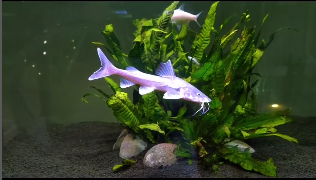
Are Shark catfish Sensitive To Water Changes?
Shark catfish are generally resilient, yet they exhibit a degree of sensitivity to sudden changes in water parameters. As they mature, they tend to prefer brackish waters, necessitating careful management of salinity levels. Stress can result from abrupt temperature or pH shifts, leaving the catfish vulnerable to various health issues. For the well-being of these fascinating creatures, gradual acclimatization to new environments is imperative.
Water quality must be diligently monitored, especially because high concentrations of nitrates and ammonia are hazardous to these fish. Ammonia particularly poses a threat, with the risk of toxicity increasing in environments of poor water quality or improper tank management. This necessitates the use of regular testing to measure water parameters and implement changes judiciously, maintaining stability and supporting the health of this unique species.
Are Shark catfish Sensitive To Ammonia?
Black Shark catfish are particularly sensitive to ammonia, which presents as a critical concern in aquarium settings. Even low ammonia levels can afflict these catfish with harmful effects, manifesting as reduced appetite, lethargy, and an elevated risk of disease. A tank’s nitrogen cycle must be well-established to prevent the accumulation of ammonia, with special attention to not overfeed, which exacerbates the issue.
Ammonia has the potential to cause significant damage to a catfish’s gills and respiratory system. Thus, ensuring effective biological filtration within the tank is non-negotiable for mitigating ammonia toxicity risks. Regular water tests are a must, allowing aquarists to swiftly rectify any harmful changes and create a healthy habitat for their delicate aquatic charges.
Are Shark catfish Sensitive To Copper?
Copper sensitivity is a notable characteristic of the Shark catfish, and as such, environments high in copper can be especially detrimental. Copper can be introduced through various means, including copper-based medications and treatments, or even water sources and decorative items within the tank. Elevated copper levels can lead to gill damage and impact the catfish’s osmoregulation, ultimately causing distress and health complications.
Aquarists must be vigilant when selecting products for the tank, ensuring that they are safe for catfish and free from copper compounds. Reading product labels carefully before use is essential to avoid unknowingly introducing harmful elements into the aquarium. To safeguard shark catfish against copper toxicity, regular monitoring of water parameters is paramount, thus providing these fish with the optimal environment they require to flourish.

